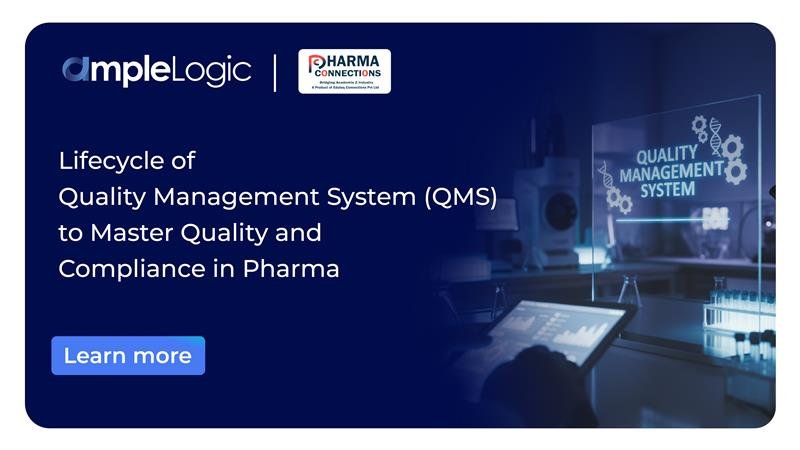
When a laboratory test in the pharmaceutical industry gives a result outside its approved limits, it is classified as an Out-of-Specification (OOS) result. Such an observation demands careful investigation to find out whether the deviation is due to an analytical error or a genuine product-quality issue.
This article explores how pharmaceutical companies conduct investigations of OOS results in analytical testing, what global regulators expect at each stage, and how digital platforms like AmpleLogic simplify and strengthen this process.
Regulatory agencies such as the FDA, EMA, WHO, and MHRA require a structured and documented OOS investigation process. OOS investigations in analytical testing are a key part of Quality Management Systems (QMS software). The goal is simple: to determine the true cause, assess its impact on product quality, and prevent future recurrence.
Why OOS Investigations Matter?
An OOS result is more than an unexpected data point. It shows how well a company’s testing and manufacturing systems perform. A well-structured investigation of OOS results in analytical testing helps ensure that every deviation is reviewed scientifically and that patient safety remains uncompromised.
Under 21 CFR 211.192, the FDA requires that every unexplained discrepancy be fully investigated and recorded, even if the affected batch has not been released. EMA’s and WHO’s Good Manufacturing Practice (GMP) frameworks echo the same requirement. An efficient investigation process protects patients, preserves data integrity, and demonstrates an organization’s scientific accountability.
Immediate Actions and Containment
When an analyst identifies an OOS result, the first step is immediate notification to the supervisor. Work on the affected batch or product is paused until the cause is reviewed. This quick containment prevents further mistakes and keeps evidence intact.
Every action, the time, person, sample, and system involved, must be documented from the very beginning. Regulators later review these records to confirm whether the company acted promptly and systematically. A systematic investigation of OOS results in analytical testing usually begins at the laboratory level, focusing on method accuracy and data reliability.
Phase I: Laboratory Investigation
The first investigation phase focuses on the analytical process.
- The laboratory supervisor and quality team review all details: instrument logs, chromatograms, calibration records, reagents, and method execution.
- The analyst may be interviewed to confirm how the test was performed and whether all procedural steps were followed.
- If an assignable cause is clearly proven – such as calculation error, sample mix-up, or instrument failure- the initial result may be declared invalid.
- A retest is then performed under controlled conditions.
The FDA OOS guidance and WHO GMP Annex 4 stress that retesting must have a sound scientific reason and all data, both original and repeat, must be retained. If no laboratory error is found, the OOS result is treated as valid, and the investigation proceeds to the manufacturing level.
Phase II: Full-Scale Manufacturing Investigation
When the lab phase cannot explain the deviation, the scope widens to include production and quality systems.
- A cross-functional team, typically from Quality Assurance, Manufacturing, and Engineering, reviews the batch records, raw material data, in-process results, and environmental logs.
- Structured root-cause tools such as the 5 Whys, Fishbone Diagram, or FMEA (Failure Mode and Effects Analysis) help trace possible contributors.
- These may include variations in raw material quality, process control failures, or equipment malfunction.
- The ICH Q10 framework encourages integrating such investigation tools into pharmaceutical quality systems.
Retesting or resampling is only allowed with scientific justification. Retesting may be done on the original retained sample if it is homogeneous and intact, while resampling involves taking new material from the batch.
The EMA’s Annex 15 and WHO guidelines clearly caution against repeated testing to achieve passing results, a practice known as “testing into compliance.”
Common Root Causes
Through industry experience, most OOS investigation results can be traced back to one or more of the following causes:
Mention 6M’s
Each category points to a different set of preventive actions, better training, clearer SOPs, improved instrument control, or enhanced raw-material verification.
Prevention Steps of OOS
Human Error and Quality Culture
Human errors contribute significantly to OOS incidents, but regulators emphasize that the term should not be used casually. According to the MHRA Inspectorate, investigators must examine whether procedural ambiguity, insufficient training, or equipment design influenced the outcome.
A healthy quality culture treats human error as a signal to strengthen systems, not as a reason for blame. Encouraging open reporting helps build learning-based quality systems.
Documentation and Data Integrity
Accurate and timely documentation forms the backbone of any OOS investigation. Every step, from initial notification to CAPA, should be traceable. Software like Amplelogic QMS helps in keeping every record for an audit trail. The FDA Compliance Program Manual 7356.002 requires firms to maintain complete records that allow investigators to reconstruct events clearly.
Manipulating or averaging data to achieve compliance is strictly forbidden under the FDA Compliance Policy Guide, Sec. 480.100. Each result must stand on its own and be reviewed scientifically.
Decision-Making and Batch Disposition
Once all reviews are complete, the Quality Unit decides on the batch’s fate, whether it will be released, reprocessed, or rejected. The decision must rely solely on documented facts and scientific logic, not on commercial pressure. Regulatory agencies expect these decisions to be made independently by the quality function, ensuring that patient safety takes precedence over operational convenience.
Corrective and Preventive Actions (CAPA)
Once the root cause is confirmed, the next step is implementing Corrective and Preventive Actions. These may involve revising analytical methods, recalibrating equipment, retraining analysts, or redesigning sampling plans. The ICH Q10 guideline stresses that CAPA effectiveness should be verified through periodic reviews and internal audits. (qms has capa mention it)
How AmpleLogic Simplifies OOS Investigations?
Modern pharmaceutical operations generate thousands of analytical results daily, often across multiple laboratories and systems. Managing OOS cases manually or through disconnected spreadsheets can slow investigations and risk compliance gaps.
AmpleLogic’s QMS platform provides an integrated OOS Management System that automates and standardizes every step of the investigation process, from detection to closure.
- One Digital System:
AmpleLogic’s OOS Management System keeps all analysts, reviewers, and QA teams on one platform. Each record captures notes, instrument data, and approvals in real time, meeting FDA 21 CFR Part 11 and EU Annex 11 requirements. - Clear Step-by-Step Process:
Every OOS investigation follows a fixed flow: lab review first, then manufacturing, and finally QA decision. Each stage is time-bound, recorded automatically, and visible to the right people. - Easy System Integration:
AmpleLogic links with LIMS, MES, etc, and with other ERP systems to pull test and batch data automatically. This reduces manual work, saves time, and avoids entry errors. - Faster and More Transparent Results:
Digital OOS investigations mean quicker turnaround, accurate records, and stronger compliance. Real-time dashboards help teams spot trends, improve processes, and build a stronger quality culture.
Global Alignment
The design of AmpleLogic’s OOS system aligns with global regulatory expectations, the FDA’s OOS guidance, EMA Annex 15, WHO GMP principles, and ICH Q10. Companies using this digital framework can demonstrate structured, data-driven investigations during audits and easily retrieve supporting evidence for inspection queries.
Conclusion
Investigating OOS results is both a scientific and compliance responsibility. It reflects how mature and transparent a company’s quality system truly is. A strong process ensures that results are handled with fairness and values that regulators and patients expect alike.
As regulatory expectations continue to evolve, digital systems like AmpleLogic empower pharmaceutical companies to maintain accuracy, traceability, and speed, not just during audits but in every batch decision that protects patient trust. A strong and transparent investigation of OOS results in analytical testing not only ensures compliance but also builds long-term trust in data integrity and product quality. When every investigation follows the same standardized digital path, the organization achieves compliance but also builds long-term trust in its data, products, and people.






























